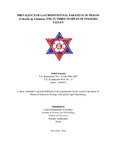Please use this identifier to cite or link to this item:
https://elibrary.tucl.edu.np/handle/123456789/1393| Title: | Prevalence of Gastrointestinal Parasites of Pigeon (Columba Sp. Linnaeus, 1758) In Three Temples of Pokhara Valley |
| Authors: | Gurung, Amrit |
| Keywords: | Gastrointestinal diseases;Parasites;Health care |
| Issue Date: | 2016 |
| Publisher: | Central Department of Zoology Institute of Science and Technology Tribhuvan University Kirtipur, Kathmandu |
| Abstract: | The present study was conducted to determine the general prevalence, identification, compare area-wise as well as infection-wise prevalence and find out activities on health care of pigeon (Columba sp.) in three temples viz. Bhadrakali temple, Bindhyabasini temple and Tal Barahi temple of Pokhara valley. A total of 120 faecal samples were collected by opportunistic random faecal sampling method on 16, 17 and 19 March, 2016 A.D. Iodine wet mount and different concentration technique (floatation and sedimentation) were used for faecal qualitative tests and verbally administered questionnaires for interview whereas Microsoft Excel 2007 and “R”, version 3.3.1 software packages were used in analyzing data. Out of 120 faecal samples examined, 83 faecal samples were positive with 69.16% prevalence of parasitic infection. Total of seven GI parasites that includes one subclass of protozoan: Coccidia 23 (19.16%) and six genera of helminths: Capillaria sp. 38 (31.67%), Ascaridia sp. 26 (21.66%), Echinostoma sp. 9 (7.50%), Syangamus sp. 7 (5.83%), Hymenolepis sp. 4 (3.33%) and Hetarakis sp. 3 (2.50%) were identified and reported first time in Nepal. The prevalence rate of helminths 66 (55%) were higher than protozoan parasites 23 (19.16%). The higher prevalence of GI parasites was in Bhadrakali temple 31 (77.50%) followed by Tal Barahi temple 29 (72.50%) and the lowest was in Bindhyabasini temple 23 (57.50). Statistically, the difference in prevalence of GI parasitic infection among study area was found to be insignificant (χ²=0.76328, P>0.05) whereas the difference in prevalence of single infection 52 (43.83%) and mixed infections 31 (25.83%) were insignificant (χ²=3.4728, P>0.05). No any activities on health care of pigeon regarding the GI parasites were found. The study indicated that pigeons in three temples of Pokhara valley were highly susceptible to GI parasites. Therefore sustainable ways for controlling the parasitic infection and further studies need to be designed for the health and conservation of pigeons. |
| URI: | http://elibrary.tucl.edu.np/handle/123456789/1393 |
| Appears in Collections: | Zoology |
Items in DSpace are protected by copyright, with all rights reserved, unless otherwise indicated.

